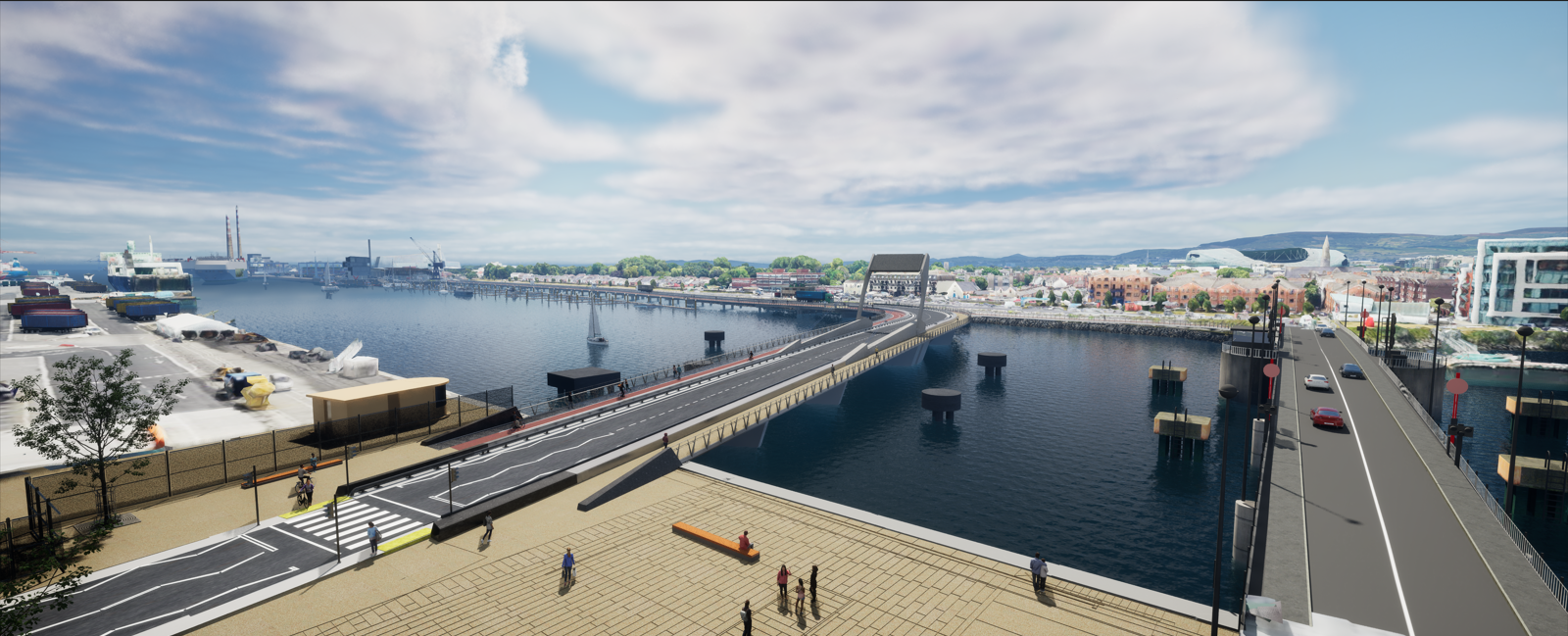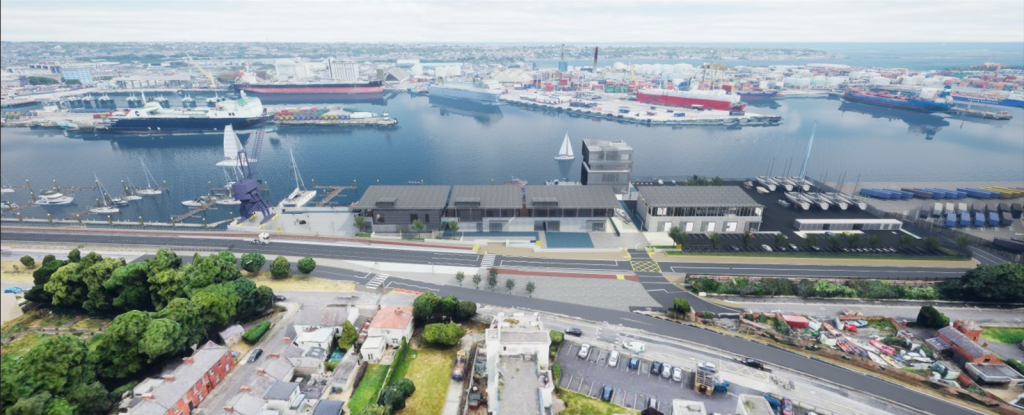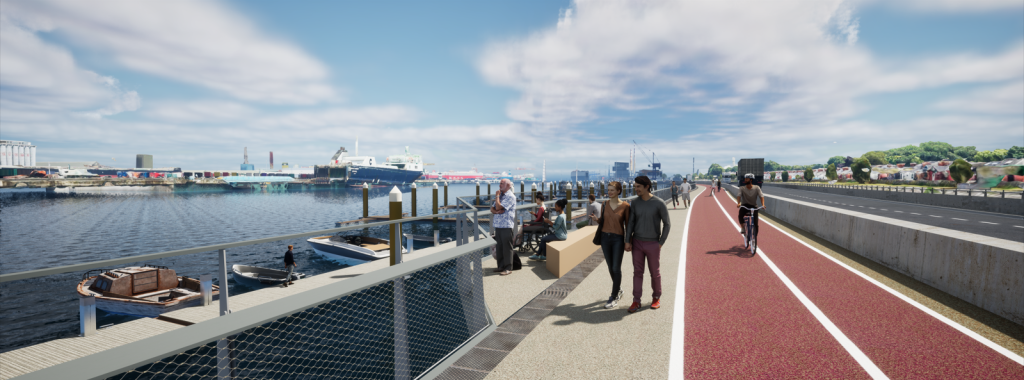Dublin Port Company lodges planning application for 3FM Project to transform port lands focused on the Poolbeg Peninsula

22 July 2024
Dublin Port Company (DPC) is submitting a planning application to An Bord Pleanála for a 15-year permission for its 3FM Project, the third and final project from Dublin Port’s Masterplan 2040 at an estimated cost of €1.1 billion (2024 prices).
The 3FM Project will be developed on existing brownfield lands in the port, focusing primarily on the Poolbeg Peninsula, where one-fifth of Dublin Port’s estate is located. The project will deliver close to 20% of port capacity required by 2040 by providing essential infrastructure and capacity for unitised cargo as demand for freight services from Continental Europe grows.
The 3FM Project includes the construction of a new bridge across the River Liffey as part of the Southern Port Access Route (SPAR), removing heavy goods vehicles (HGVs), port and commercial traffic from existing public roads leading to and from the Tom Clarke Bridge, while giving pedestrians, cyclists and public transport users 7.0 km of cycle and pedestrian routes for active travel across the Poolbeg Peninsula and River Liffey. In addition, a new Maritime Village, public park and enhanced public and community amenity will be provided, all designed to improve and protect the port’s local community, natural environment and maritime heritage.
The project, put forward by self-financing commercial semi-state Dublin Port Company, is the largest port infrastructure project in the company’s 317-year history. It completes the three core strategic infrastructure projects brought forward for development from Dublin Port’s Masterplan, with the ABR Project near completion and the MP2 Project under construction.
Plans On Display to Public
DPC’s final design proposal reflects extensive public consultation and collaboration with stakeholders, including the port’s local community, customers, public representatives, State agencies, Government departments and a wide range of public bodies to balance a range of commercial, community, heritage and sustainability considerations.
Public information sessions will take place in August with details of the proposed development plans on view, and with Dublin Port’s project team on hand to discuss these in person.
|
4pm – 8pm |
Tues, 13th August 2024 |
Poolbeg Boat & Yacht Club, Dublin 4 |
|
Wed, 14th August 2024 |
Clanna Gael Fontenoy GAA Club, Dublin 4 |
|
|
Thurs, 15th August 2024 |
Clontarf Parish Hall, Dublin 3 |
Barry O’Connell, Chief Executive, Dublin Port Company, said:
“Today we are putting forward the 3FM Project to develop critical national port infrastructure on existing port lands to support growth in the Irish economy.
“The 3FM Project is a powerful example of a balanced approach to sustainable planning for major infrastructure that delivers for international trade, the local community, and the port’s natural environment.
“We have embraced the consultation process and taken on board the views of many stakeholders to create a plan that delivers on Dublin Port’s core mandate to facilitate international trade. It does this by maximising our current footprint to create state-of-the-art capacity for import and export trade which is the mainstay of our economy, and which is fundamental to future economic growth.
“Dublin Port is already one of Europe’s most efficient ports. For business, the 3FM Project means essential port infrastructure that supports Ireland’s export ambitions into the future. For consumers, this infrastructure will support competitive shipping routes for the goods and materials we use in everyday life, from building and health supplies to furniture and grocery.
“Our project design not only creates a more efficient port but does so in a way that enhances our community, protects our environment and respects our heritage. For the local community and future residents, it creates new and enhanced public amenities, including a world class Maritime Village, 7km of pedestrian and cycle routes, a new public park and wildflower meadow, as well as a floodlit playing pitch for local clubs.
“In relation to the Great South Wall, a new Public Access Feasibility Study and up to €1 million in funding to implement its recommendations, will look at the possibilities for public interpretation, access, facilities and conservation.
“At the same time, the project uses construction techniques for a new container terminal facility that will enhance our environment and the biosphere, utilising open-piled structures to protect marine biodiversity and incorporating infrastructure to support the low-carbon operation of the terminal. Relocating the container freight stacking operation further away from residential areas also ensures lesser noise and visual impact.
“We are very grateful to the many contributors for their input into this plan, which will transform our lands on the Poolbeg Peninsula for the port, the city, and its residents.”
About the 3FM Project in Detail
The 3FM Project involves an application for a 15-year permission for phased development works within existing port lands, focused primarily on the southern port estate on the Poolbeg Peninsula.
The 3FM Project has six key elements:
1. Construction of a new public road and bridge called the Southern Port Access Route (SPAR) to link the north and south port areas including a new opening bridge over the River Liffey. This will facilitate HGVs, pedestrians, cyclists, blue light services and public transport users moving to and from the South Port and Poolbeg Peninsula. The SPAR will also allow the 3FM Project to be rail enabled through rapid road shunting of freight from the South Port, across the Liffey, to rail intermodal facilities in the North Port vicinity.
2. Construction of a new Lift-on Lift-off (Lo-Lo) Terminal with an annual throughput capacity of 550,000 Twenty-foot Equivalent Units (TEU) or 5.34m tonnes. The LoLo terminal will be located north of the ESB’s Generating Station, with 650m of deep water berthage plus associated cargo handling areas (Dublin Port Masterplan Area N) to accommodate Lo-Lo vessels of up to 240m. It will operate in conjunction with a transit container storage yard located on waterside land currently used for bulk cargo handling (Dublin Port Masterplan Area L).
3. Replacement of the existing Lo-Lo container terminal, currently operated by Marine Terminals Limited (MTL), with a new Roll-On Roll-Off (Ro-Ro) Terminal with an annual throughput capacity of 360,000 Ro-Ro units or 8.69m tonnes. The Ro-Ro terminal will be located at existing Berths 42-45 including provision of two berths, each with a single tier Ro-Ro ramp, plus associated cargo handling facilities (Dublin Port Masterplan Area K).
The terminal will operate in conjunction with a transit Ro-Ro trailer yard located on Port owned land on the southern side of the Poolbeg Peninsula (Dublin Port Masterplan Area O). This combined terminal will accommodate Ro-Ro vessels of up to 240m length, primarily from Continental Europe.
There will be no stacking of containers or trailers, nor use of gantry cranes in Area O, where ground level, single height freight trailers will be completely hidden from Sandymount Strand.
4. Provision of a 325m diameter ship turning circle in the river channel north of Pigeon House Harbour, dredged to a depth of -10.0m CD. The ship turning circle will enablesafe navigation and efficient manoeuvring of vessels up to 240m in length.
5. Construction of a Maritime Village at Pigeon House Road and Berth 41. This village will accommodate local rowing, sailing, and boat clubs and will provide a significantly enhanced public realm and facilities on the waterside.
The 3FM Project will require the demolition of the existing boating facilities to make way for the proposed SPAR. The existing facilities will be replaced by the construction of the Maritime Village which will have a significantly larger footprint including the hinterland to Berth 41 (currently part of the existing Lo-Lo Container Terminal operated by MTL).
6. Construction of Community Gain elements, which collectively represent a substantial and meaningful community proposal, including:
Enhanced recreational amenity through:
· 7.0km of Active Travel Paths (cycle, pedestrian, wheelers etc.) and 4.9km of new or upgraded footway for the SPAR and Poolbeg Peninsula, which will link with the 1.4km Liffey Tolka Greenway in the North Port, and from there to the 4.0km Tolka Estuary Greenway currently under construction by Dublin Port. DPC will alsoprovide Dublin City Council with a €5 million contribution for future upgrading of the existing coastal path along the southern perimeter of the Poolbeg Peninsula.
· Development of a sailing, rowing and maritime campus (Maritime Village) adjacent to the existing Poolbeg Yacht and Boat Club in consultation with local sailing and boating clubs, including a public slipway and facilities for maritime skills training.
· Provision of recreational space in the form of Port Park and Wildflower Meadow (2.5ha) and Coastal Park (1.6ha), and 1.1ha extension to Irishtown Nature Park, and development of a new floodlit playing pitch within Port Park for the use of local football clubs.
Enhanced public realm through the development of a new public plaza as a key part of the Maritime Village, and extensive boundary softening works adjacent to the development sites forming part of the 3FM Project.
Community support through the establishment of a new €2 million Community Benefit Fund for Education, Heritage & Maritime Training Skills projects within the Poolbeg area. The initial capital for the Fund will be administered by DPC in consultation with local stakeholders.
Heritage & Biodiversity enhancements through:
· An innovative design approach that will use open-piled structures to protect marine biodiversity by preventing significant infilling of the River Liffey, while also being future-proofed against climate change impacts.
· Sustainable construction practices, low-carbon materials, and energy-efficient infrastructure that will reduce the port’s environmental impact.
· Commissioning a new Public Access Feasibility Study regarding the Great South Wall to identify improved public interpretation, accessibility, facilities and conservation possibilities, with up to €1 million funding to implement the study recommendations.
· Construction of an additional permanent marine structure (dolphin) to expand the available habitat and range of the Dublin Port Tern Colonies.
· Provision of Interpretative Markers to delineate the alignment of the Great South Wall.

Other significant ancillary works include:
- Improvements to the existing road network in both the North and South Port, linking and providing access to the port terminals.
- Improved pedestrian access from Irishtown to the proposed Maritime Village.
- Demolition of the existing Poolbeg Oil Jetty and Sludge Jetty.
Public Consultation
The application for permission, the Environmental Impact Assessment Report and the Natura Impact Statement, will be available to inspect during public opening hours for 8 weeks from 31st July 2024 at:
- The Offices of An Bord Pleanála 64 Marlborough Street, Dublin 1.
- The Offices of Dublin City Council, Civic Offices, Woodquay, Dublin 8.
- The Offices of Dublin Port Company, Port Centre, Dublin Port, Alexandra Road, Dublin 1.
The application may also be viewed / downloaded from the project website: www.dublinport3fm.ie which will be live from 31 July 2024.
Submissions or observations may be made only to An Bord Pleanála up until 5.30 pm on 25th September 2024. See www.pleanala.ie for further details.

